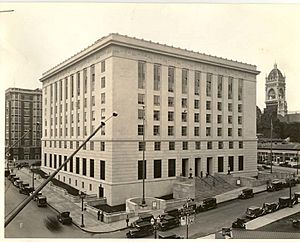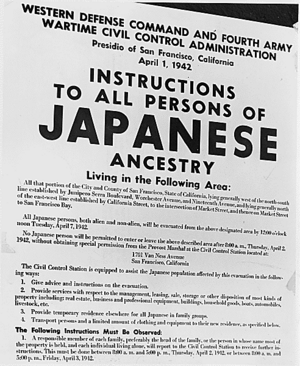Yasui v. United States facts for kids
Quick facts for kids Yasui v. United States |
|
|---|---|

|
|
| Argued May 10–11, 1943 Decided June 21, 1943 |
|
| Full case name | Minoru Yasui v. United States |
| Citations | 320 U.S. 115 (more)
63 S. Ct. 1392, 87 L. Ed. 1793, 1943 U.S. LEXIS 461
|
| Prior history | U.S. v. Minoru Yasui, 48 F. Supp. 40 (D. Or. 1942) Certificate from the Circuit Court of Appeals for the Ninth Circuit |
| Subsequent history | United States v. Minoru Yasui, 51 F. Supp. 234 (D. Or. 1943) |
| Holding | |
| The Court held that the application of curfews against citizens was constitutional. | |
| Court membership | |
| Case opinions | |
| Majority | Stone, joined by unanimous |
| Laws applied | |
| 18 U.S.C.A. s 97a Executive Order 9066 U.S. Const. |
|
Yasui v. United States was an important case heard by the Supreme Court of the United States in 1943. It was about whether it was fair to make American citizens follow curfews during World War II. These curfews were part of Executive Order 9066. This order allowed the U.S. military to create special "exclusion zones" on the West Coast of the United States. People of Japanese heritage living there had to follow curfews. Eventually, many were moved to special camps. This order came after the attack on Pearl Harbor. That attack brought America into World War II and made anti-Japanese feelings in the country much stronger.
The Supreme Court decided that applying curfews to citizens was allowed by the Constitution. This case was heard at the same time as Hirabayashi v. United States. Both cases were decided on June 21, 1943. The court upheld the decision against Minoru Yasui, who was born in the U.S. The court sent the case back to a lower court for a new decision on his punishment. This was because the lower court had first said the curfew didn't apply to citizens. But it also said Yasui had given up his citizenship by working for the Japanese government. The Yasui and Hirabayashi decisions, along with later cases like Ex parte Endo and Korematsu v. United States, helped decide if the curfews and forced moves during the war were legal. Years later, in the 1980s, new information led to Yasui's original ruling being overturned.
Contents
Why This Case Happened
On September 1, 1939, Nazi Germany invaded Poland, which started World War II. For two years, the United States stayed out of the fighting. But then, on December 7, 1941, Japan attacked Pearl Harbor. This brought the U.S. into the war.
U.S. President Franklin D. Roosevelt was worried about people of Japanese heritage in America. He thought some might secretly help Japan. So, on February 19, 1942, he issued Executive Order 9066. This order gave the military power to create special zones. People of Japanese heritage, mostly on the West Coast of the United States, were forced to move from these zones. They were sent to internment camps further inland. On March 23, 1942, General John L. DeWitt set rules for people of Japanese heritage. These rules included a curfew from 8:00 pm to 6:00 am.
Minoru Yasui's Challenge
Minoru Yasui was born in 1916 in Hood River, Oregon. He went to the University of Oregon and then its law school. In 1940, Yasui, who was also a U.S. Army reservist, started working at the Japanese Consulate in Chicago. He left that job on December 8, 1941, and went back to Hood River.
On March 28, 1942, Yasui purposely broke the military curfew in Portland, Oregon. He walked around downtown after 11:00 pm. Then, he went to a police station. He did this to challenge the curfew and see if it was legal.
The First Court Case
On June 12, 1942, Judge James Alger Fee started Yasui's trial. This was the first case to challenge the curfew in court. The trial took place at the Federal Courthouse in Portland.
On November 16, 1942, Judge Fee made his decision. He said the curfew could only apply to people who were not citizens. This was because the government had not declared martial law. However, he also ruled that Yasui had lost his citizenship by working for the Japanese government. So, the judge said the curfew did apply to Yasui. Judge Fee ordered Yasui to spend one year in jail and pay a $5,000 fine. This federal court ruling, which involved big questions about the Constitution and war powers, was news across the country.
Yasui then appealed his case. It went to the United States Court of Appeals for the Ninth Circuit. After hearing arguments, that court asked the Supreme Court of the United States to answer two questions. The Supreme Court then decided to take over the entire case. This meant the Ninth Circuit no longer had to deal with it.
The Supreme Court's Decision

The Supreme Court heard arguments for Yasui's case on May 10 and 11, 1943. Charles Fahy argued for the United States. Minoru Yasui's lawyers were E. F. Bernard and A. L. Wirin.
On June 21, 1943, the court announced its decision. It was released on the same day as the Hirabayashi v. United States case. Chief Justice Stone wrote the court's opinion. He said that the curfew and exclusion orders were legal. He also said they were legal even when applied to U.S. citizens.
In the Yasui case, the court upheld his conviction for breaking the curfew. But they ordered that his punishment be decided again. This was because the lower court had said the curfew wasn't valid for citizens. It also said Yasui had given up his citizenship. The Supreme Court sent the case back to the lower court. This was so a new punishment could be decided based on these new points.
What Happened Next
When the case went back to Judge Fee, he changed his earlier decision. He removed the part that said Yasui was no longer a U.S. citizen. Judge Fee also removed the fine and reduced Yasui's jail time to 15 days. Yasui was released and moved into one of the Japanese internment camps.
The case of Korematsu v. United States was decided the next year. It became more famous than the Yasui and Hirabayashi cases. Legal experts started to question these decisions even before the war ended. People criticized the cases for being unfair and based on racism. Later, it was discovered that officials in the United States Department of Justice had lied to the court during the trials.
Overturning the Conviction
On February 1, 1983, Yasui asked the Oregon federal court to review his case. He did this because new information showed that the Department of Justice had hidden facts. Yasui said the government had kept evidence secret. This evidence was about whether there was a real threat of a Japanese attack on the U.S. mainland.
The court agreed to dismiss the original charges and conviction against Yasui. This happened at the government's request. Yasui then tried to appeal, but the appeals court dismissed his appeal for technical reasons. However, the Ninth Circuit Court of Appeals later did overturn Hirabayashi's conviction. This meant that Yasui was also seen as innocent. In 2011, the U.S. Solicitor General's office publicly admitted that the Justice Department had acted unethically in 1943. Minoru Yasui passed away on November 12, 1986.
Lawyers who helped Fred Korematsu, Gordon Hirabayashi, and Minoru Yasui overturn their convictions later sent a letter. On January 13, 2014, they wrote to Solicitor General Donald Verrilli Jr.. They asked him to request that the Supreme Court officially overturn its decisions in Korematsu, Hirabayashi, and Yasui. If the Solicitor General wouldn't do this, the lawyers asked the government to state clearly that these internment decisions are not valid reasons to hold people or groups without a fair legal process.
Images for kids




